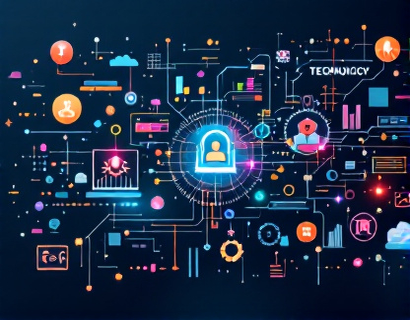Revolutionizing Digital Interactions: The Synergy of Crypto and AI
The intersection of cryptocurrency and artificial intelligence is giving rise to a new era of digital innovation, fundamentally transforming how users interact with apps and services. This convergence is not just about merging two advanced technologies but about creating a seamless, secure, and highly personalized digital experience. As we delve into this topic, we will explore the latest advancements in tech-driven solutions that are redefining user engagement and setting the stage for the future of digital services.
Understanding the Basics: Crypto and AI
To fully appreciate the impact of this synergy, it's essential to understand the fundamental concepts of both cryptocurrency and artificial intelligence. Cryptocurrency, often referred to as digital or virtual currency, operates on a decentralized network known as a blockchain. This technology ensures transparency, security, and immutability, making it an ideal foundation for various financial and non-financial applications.
Artificial intelligence, on the other hand, encompasses a range of technologies designed to simulate human intelligence processes such as learning, reasoning, and self-correction. AI algorithms can analyze vast amounts of data, recognize patterns, and make decisions with minimal human intervention. When combined, these technologies can create powerful tools that enhance user experiences and drive innovation.
The Role of Blockchain in Enhancing Security and Trust
One of the most significant contributions of blockchain technology to the crypto-AI synergy is its role in ensuring security and trust. In traditional systems, central authorities manage and validate transactions, which can be vulnerable to breaches and fraud. Blockchain's decentralized nature eliminates the need for intermediaries, reducing the risk of tampering and increasing transparency. This is particularly crucial when integrating AI into digital services, as it ensures that user data and transactions are secure and verifiable.
For instance, in a smart contract environment, AI algorithms can execute complex tasks automatically while ensuring that all conditions are met and that the transaction is recorded on the blockchain. This not only enhances security but also builds trust among users, who can verify the integrity of the system independently.
AI-Driven Personalization in Crypto Applications
Personalization is a key factor in enhancing user engagement, and AI plays a pivotal role in achieving this in the crypto space. By leveraging machine learning algorithms, platforms can analyze user behavior, preferences, and historical data to provide tailored recommendations and services. This level of personalization is transformative, as it allows users to interact with digital services in a way that feels intuitive and relevant to their needs.
For example, a crypto trading platform can use AI to analyze a user's trading history and market trends to suggest optimal trading strategies. This not only improves the user's decision-making process but also increases their confidence in the platform, leading to higher engagement and retention rates.
Enhancing User Experience Through Predictive Analytics
Predictive analytics, a subset of AI, is another powerful tool that can be harnessed to enhance user experiences in crypto applications. By analyzing vast datasets, AI can predict future trends and user behaviors, enabling platforms to proactively address user needs and preferences. This predictive capability is invaluable in a market as volatile as cryptocurrency, where timely insights can make a significant difference.
Consider a crypto wallet application that uses predictive analytics to alert users about potential price movements based on historical data and current market conditions. Such features not only provide users with valuable information but also empower them to make informed decisions, thereby increasing their satisfaction and loyalty to the platform.
Decentralized Identity Management
Identity management is a critical aspect of digital services, and the combination of crypto and AI offers innovative solutions to this challenge. Decentralized identity management systems use blockchain to create secure and self-sovereign identities for users. AI can enhance these systems by managing and verifying identities in real-time, ensuring that only authorized users access specific services.
For instance, a decentralized social media platform can use AI to verify user identities and manage access controls, ensuring that personal data is protected and that users have full control over their information. This not only enhances security but also complies with stringent data protection regulations, such as GDPR.
Automated Customer Support with AI Chatbots
Customer support is an area where the integration of AI and crypto can significantly improve user experiences. AI-powered chatbots can provide 24/7 assistance, handling a wide range of queries and transactions with high efficiency. In the crypto space, where users often deal with complex financial operations, having a reliable and responsive support system is crucial.
These chatbots can be integrated with blockchain-based wallets and exchanges, allowing them to handle transactions, provide real-time updates, and offer personalized support based on the user's history and preferences. This level of automation not only reduces the workload on human support teams but also ensures that users receive immediate and accurate assistance.
Tokenization of Assets and AI Optimization
Tokenization, the process of converting assets into digital tokens on a blockchain, is another area where AI can add significant value. By combining tokenization with AI, platforms can optimize asset management, pricing, and distribution. AI algorithms can analyze market data and user behavior to determine optimal token prices, ensuring fair and efficient transactions.
For example, in the real estate sector, AI can help tokenize properties by analyzing factors such as location, market demand, and historical performance to set fair token prices. This not only makes real estate more accessible to a broader audience but also enhances the liquidity of these assets, benefiting both investors and users.
Enhancing Fraud Detection and Prevention
Fraud is a persistent issue in the digital world, and the convergence of crypto and AI offers robust solutions to detect and prevent fraudulent activities. AI algorithms can analyze transaction patterns and user behavior to identify anomalies and potential fraud in real-time. This proactive approach is essential in the crypto space, where the decentralized and anonymous nature of transactions can make fraud detection challenging.
For instance, a blockchain-based payment system can use AI to monitor transactions and flag suspicious activities, such as multiple failed login attempts or unusual transfer patterns. By automatically alerting users and platform administrators, these systems can prevent financial losses and maintain the integrity of the platform.
The Future of Digital Innovation: Opportunities and Challenges
The synergy between crypto and AI is opening up numerous opportunities for innovation in the digital space. However, it also comes with its own set of challenges that need to be addressed. One of the primary concerns is the regulatory landscape, as governments around the world are still grappling with how to regulate these emerging technologies. Ensuring compliance while fostering innovation is a delicate balance that requires collaboration between stakeholders.
Another challenge is the technical complexity involved in integrating AI with blockchain systems. Developing scalable and efficient solutions that can handle the high transaction volumes and computational demands of both technologies is a significant hurdle. However, as the industry continues to evolve, we can expect to see more robust and user-friendly solutions emerge.
Conclusion: Embracing the Future of Digital Experiences
The convergence of cryptocurrency and artificial intelligence is revolutionizing the way we interact with digital services, offering enhanced security, personalization, and efficiency. As these technologies continue to advance, we can expect to see even more innovative applications that transform the digital landscape. For tech enthusiasts and professionals, this is an exciting time to explore the possibilities and contribute to shaping the future of digital innovation.










































